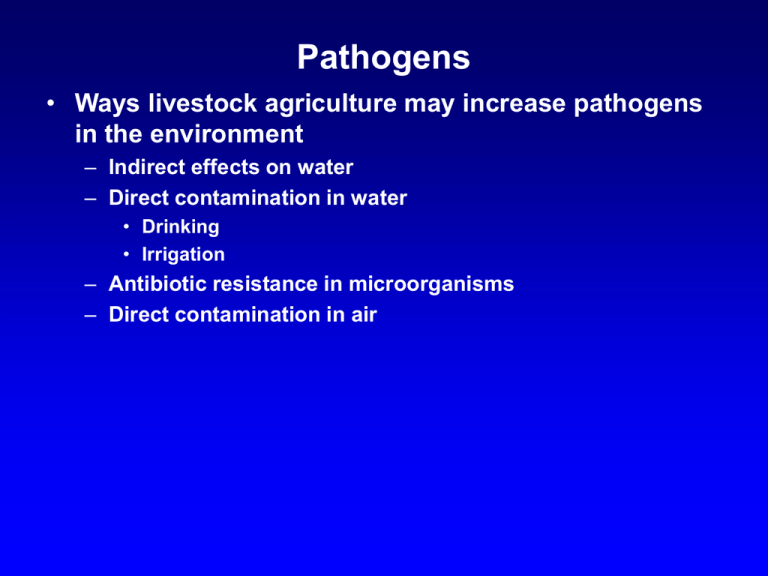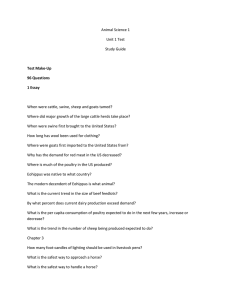Pathogens Ways livestock agriculture may increase pathogens in the environment
advertisement

Pathogens • Ways livestock agriculture may increase pathogens in the environment – Indirect effects on water – Direct contamination in water • Drinking • Irrigation – Antibiotic resistance in microorganisms – Direct contamination in air • Indirect effects on pathogens in water – Effect Excess N or P Blooms of toxic algae Pfiesteria piscidida (Red tides in marine environments) Cyanobacteria (called blue-green algae in fresh water) Toxins Contact causes confusion, memory loss and gastrointestinal problems Toxins Can kill livestock – Control • Reduction of N and P excretion and losses during storage and application • Direct pathogen contamination of water – Major microorganisms of concern • Protozoa • Bacteria • Viruses Cryptosporidium parvum Giardia E. Coli O157:H7 Bovine rotavirus Bovine coronavirus Effects (Particularly severe in very young, elderly, or individuals with compromised immunity) Severe diarrhea, vomiting fatigue, dehydration Bloody diarrhea, dehydration, kidney failure Diarrhea – Number of cases Cryptosporidium parvum Giardia E. Coli O157:H7 US Outbreaks (1989-96) Drinking water Recreational water Surface Ground Natural Pool 4 4 2 11 12 6 4 5 0 3 7 1 – Reasons for problems these organisms • The organisms or their reproductive forms are shed by infected animals in large numbers • The organisms survive and remain infectious in the environment for long periods – Some are resistant to water treatment • E. Coli O157:H7 can multiply outside the host if adequate nutrition • Low dose needed for infection • Wide range of animal hosts – Other potentially harmful bacteria in the environment • • • • Campylobacter Listeria monocytogenes Salmonella Mycobacterium paratuberculosis – Causes Johne’s Disease – Association with Crohn’s disease in humans – Risk is largely unknown 5000 Downstream 4500 Upstream Fecal Coliform, CFU / 100 ml 4000 3500 3000 2500 2000 1500 1000 500 0 29 v No ov ct O N 8- 25 ct p Se p Se g Au g Au O 9- 27 13 30 15 ug l Ju A 8- 31 • Most studies on water quality have demonstrated that poor manure management increases fecal coliforms in water supplies • Relationship between fecal coliforms and pathogens has not been established • Difficult to separate contamination from humans, domestic animals and wild animals • Pathogenic organisms – Cryptosporidium parvum • Life cycle (1 – 8 days) Oocysts consumed by host animal (Contain 4 sporozoites) Sporozoites released in intestine Sporozoites invade intestinal cells and reproduce in cells New sporozoites invade new cells Oocysts released in feces Damage intestinal cells Severe diarrhea • Oocysts in 39 to 87% of US surface waters • Hosts – Species » Humans » Domestic livestock (Cattle, sheep, goats, swine, horses) » Companion animals (Dogs, cats) » Wildlife (Mice, Raccoons) – Age » Calves 50% of calves shed oocysts between 1-3 weeks Few shed in cattle > 6 months » Swine Shed oocysts during nursing and weanling stages » Foals Shed oocysts up to 19 weeks » Sheep Adult ewes will shed oocysts around lambing • Viability characteristics – Resistant to most public water treatments – Very susceptible to drying » 2 hours of dryness is lethal – Very susceptible to high temperatures » >100oF – Susceptible to freezing temperatures » Freezing for 10 days reduced viability by 90% – Susceptible to pH>9.0 » Public water treatment plants often treat water to pH 12.0 – Oocysts remain in upper soil unless transported to ground water with macropore flow – Giardia • Life cycle (7-9 days) Cysts ingested (Contain trophozoites) Trophozoites attach to upper small intestine Severe diarrhea Produce cysts Cysts released Cysts release more in feces trophozoites • Cysts are present in most surface waters • Hosts – Species » All mammals, some birds, reptiles, and amphibians – Age » Occurs at all ages, but most common in animals that are less than 6 months • Viability characteristics – Similar to Cryptosporidium • No evidence of human infection from domestic livestock – Escherichia Coli O157:H7 • A potentially deadly bacteria – Causes bloody disease, dehydration and kidney failure – Particularly hazardous to young, elderly, and compromised immune systems – Infection can occur with as few as 10 cells • Life cycle – E. Coli O157 is consumed from water troughs or moist rations » Can survive in water trough for 4 months – E. Coli only present in cattle for 1 to 2 months » More frequent in cattle fed high grain diets Feeding forage at the end of finishing will decrease numbers Role of distillers grains??? » More common in summer than winter » More frequent in cattle that are 3 – 18 months old than mature cows » More frequent in large herds – Excreted in feces as viable bacteria – Capable of multiplying in the environment » Dependent on nutrients » Usually decrease over time • Viability – E. Coli O157:H7 are killed by chlorine, high temperature, drying, aerobic storage • At this time, few cases of direct human infection through water – Contamination of spinach believed to occur from irrigation water with a feedlot ½ mile away » E. Coli may be transported by flow, adhesion of soil particles or motility. • Factors affecting extent of pathogen problem – Size of loading dose • Percentage of herd infected • Frequency on manure addition to storage • Amount of dilution – Length of storage – Manure treatment • Anerobic > Aerobic > Compost – Storage characteristics • • • • • • • Aerobic/anerobic Drying Temperature Freeze/thaw pH Nutrients Inhibitors – Form of organisms excreted • Cysts or oocysts > vegetative forms – Routes of pathogen contamination • Run-off from bare lots • Direct deposit in pastures or lots • Run-off from manure application – Vegetation on land application • Tall forage reduces run-off – Prevents microorganisms from reaching water sources • Tall forage provides shade and moisture – Increases survivability – Soil of land application area • Organic or clay soils trap protozoa and bacteria • E. Coli can move rapidly through saturated soils or soils with macropores • Control of pathogen transport from livestock units – Prevent import of pathogen onto farm • Feed feedstuffs not contaminated with feces from rodents or other livestock – Prevent infestation of rodents or other wild or domestic animals in feed storage areas – Purchase feeds from sources that prevent fecal contamination of feedstuffs • Provide water sources with low risk of pathogen contamination – Keep livestock out of streams and ponds » Provide alternate water sources – Divert precipitation run-off from livestock facilities • Purchase livestock from sources with good health management – Avoid purchases from sales barns – Separate and quarantine new animals • Avoid transport of manure onto farm – Have visitors wear plastic boots – Thoroughly clean tires on vehicles – Prevent amplification and proliferation of organisms on farm • Frequent cleaning and drying of housing units – Particularly maternity areas • Use separate implements for feeding and cleaning • Frequent cleaning of equipment – Tires and blades • Provide feed and water free of fecal contamination from livestock, pets, rodents, wildlife, and humans • No feeding of wasted adult feed to young livestock • Segregate calves by age – Prevent contact of calves < 3 months with older cattle • Prevent run-off from entering or leaving areas housing young animals – Limiting pathogen proliferation during manure storage • Store manure from animals less than 6 months separate from mature animals and spread on non-hydrologically sensitive areas – If calf manure can’t be stored in area that restricts leaching or run-off, mix it with manure from mature cattle and apply by Best Management Practices (Dilutes organisms) • Composting at 140oF will kill most pathogenic organisms and cysts – Prevention of pathogen contamination by manure application • Application methods – Incorporation into the soil » Particularly effective during wet weather » Reduces risk of contamination of water sources by: Adsorption of organisms to soil particles Filtration of organisms Attack by predator organisms Freeze-thaw activity – Surface application » Effective in dry weather » Reduces risk by: Drying UV light • Hydrologic considerations – Avoid manure application in major water flow paths – Should consider: » Soil permeability » Slope steepness » Flood plains » Flow paths • Grassland manure application considerations – Manure should be stored for at least 60 days – Manure should be applied at least 30 days before grazing – Grass should be short when manure is applied – Pastures fertilized with manure should only be grazed by mature animals – Preventing export of pathogens from farm • Control run-off from livestock facilities – Particularly facilities housing young animals – Place cow winter feeding areas away from streams • Utilize buffer strips – Grass strips lining sides of streams or ponds – Width » > 4.5 m from field with manure application » > 10 – 20 m from animal feeding operations – Effective as part of a group of Best Management Practices » Should not be relied on as only practice • Proper grazing management – Use of rotational grazing » More uniform distribution of manure – Avoid over-grazing – Limit or prevent access of water bodies to animals • Release of antibiotic resistant microorganisms into the environment – Numerous antibiotics fed at subtherapeutic levels to promote growth and feed efficiency • Chlortetracycline, Oxytetracycline, Penicillin, Bacitracin, Tylosin – Actions • Prevent subclinical disease • Increases nutrient absorption • Improves metabolic processes – Increases rate of protein synthesis – Problem • Selection of organisms that are resistant to antibiotics – Concern for penicillin, tetracyclines, and erythromycin • Organisms released from non-sealed lagoons and from surface-applied manure – Recommend • Proper use of antibiotics – Don’t use antibiotics as a substitute for good management – Rotate antibiotics used on operation • Proper manure storage – No run-off or leakage • Proper manure application – Minimize run-off • Direct contamination of the air – Endotoxin • Lipopolysaccharide component of the cell wall of gram-negative bacteria • Problem in confinements, not in outside environment • Health effects on works in confinement buildings – – – – – Cough Chest tightness Headache Fever Flu-like symptoms • Control dust control measures





